GetSafe Medical Alert Review
Flexible, high quality medical alert systems that don’t need to be worn
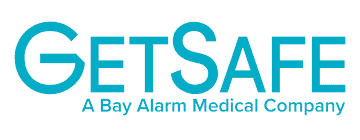
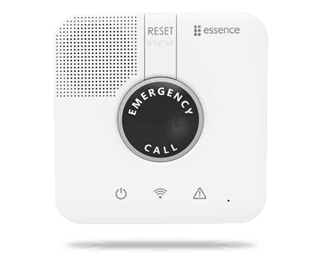
SafeHome.org may receive compensation from some providers listed on this page. Learn More
We may receive compensation from some providers listed on this page. Learn More
Flexible, high quality medical alert systems that don’t need to be worn


Did you know that one in three people, aged 65 and older, falls each year?1 It’s hard to believe that the number is so high, but it’s true.
With this in mind, it is understandable why loved ones like the measure of safety that medical alert systems provide. But we also understand that some seniors dislike wearing the device that goes with them. Maybe the device is uncomfortable, seems unattractive, or is difficult to remember to wear.
These are the seniors that GetSafe aims to protect.
Their website claims: “The GetSafe medical alert system is designed to work around you, not ON you.”
Now, we’ve tested more than a few dozen medical alert systems over the years. Most of them, like Bay Alarm Medical, cover a lot of ground by offering multiple products for the home, the car, and seniors on the go (read more in our guide to Bay Alarm Medical pricing). GetSafe does things a little differently – it makes a medical alert system for the home that you don’t need to wear.
So does GetSafe do that one thing well?
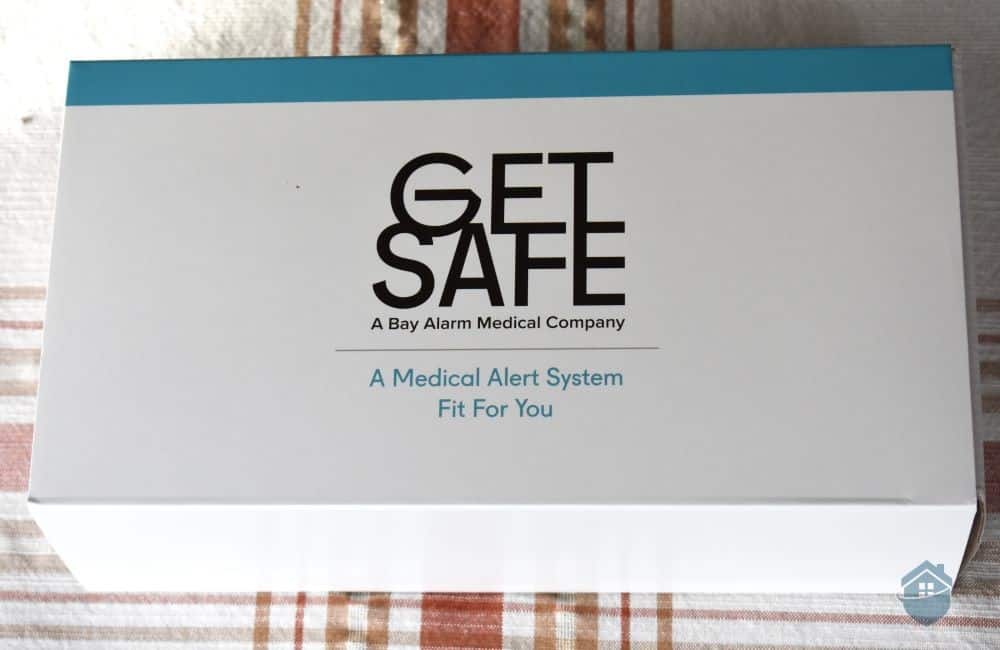
GetSafe Packaging
We spent several days testing the standard GetSafe system as we worked on figuring this out. And today, we’re sharing our full experience with GetSafe in this deep-dive review.
For a quick overview, GetSafe gets good ratings from us in the customer service and ease of use departments. This is a system you can basically set up and forget about, until of course, you need it. There are no batteries to charge on a regular basis, although we recommend testing the connection of the main base station at least once a week.
However, it gets a lower-than-average score in the features and technology department, not because the system doesn’t work, but because we think there’s room for improvement to further maximize its protection. You’ll see what we mean in a minute. For now, here’s an introduction to GetSafe.
Check out more recommendations from the SafeHome team:
While GetSafe makes just one type of medical alert system, it does offer three different packages — the Starter, Standard, and Select.
For seniors who live in a small condo or apartment with one bedroom, we think the Starter package is probably a good call. If you go this route, you will receive a base unit and one wall button.
The Standard package is the most popular GetSafe alert and is recommended for homes with two or three bedrooms and up to two bathrooms. It includes a base unit, two mini-consoles, one wall button, and one complimentary lanyard. We ordered the standard package and were a bit confused after unpacking the equipment as the box included four pieces of equipment rather than five, as advertised on their website (but more on this later).
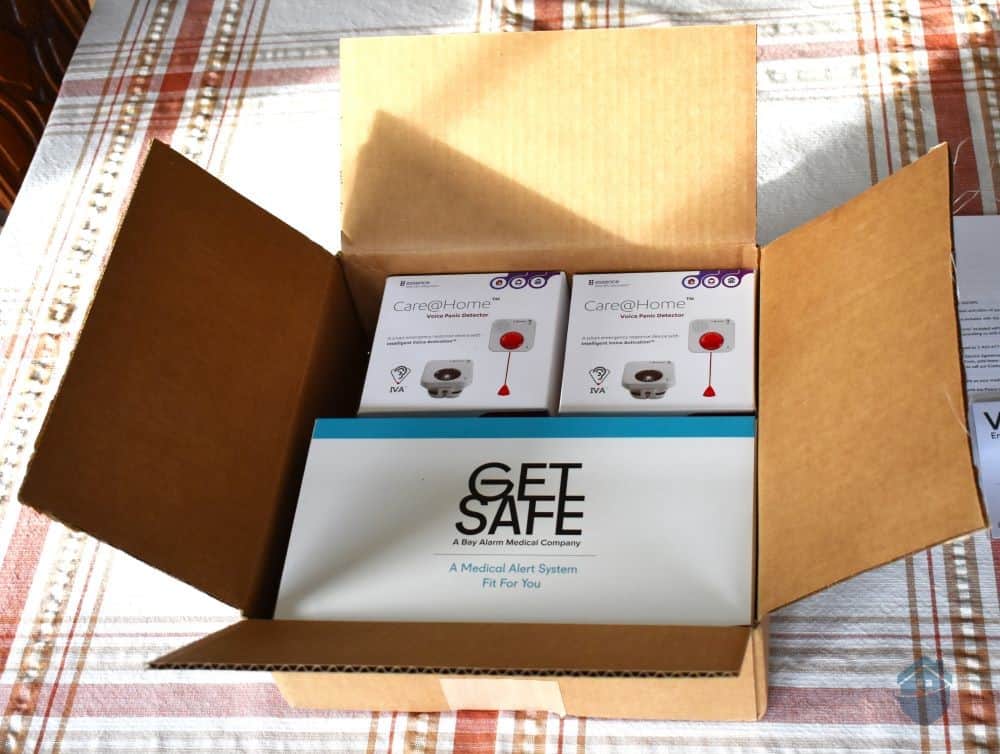
Unboxing GetSafe
For those who have a larger living space with more than two levels, bathrooms or stairways, we think paying a little extra and getting the Select package makes sense. If you pick this package, you should have plenty of devices to spread around your home, including a base unit, three mini consoles, two wall buttons, and a complimentary lanyard.
The monthly fee for all three of the packages is the same. At $29.95, we felt that this was a reasonable cost; when comparing it to other alert systems, it is actually on the lower end of the scale. However, the upfront cost of GetSafe could put a dent in your wallet. The price of the Starter equipment is $79; the Standard equipment is $179, and the Select equipment is $279.
Note that the somewhat pricey upfront cost is due to GetSafe’s policy requiring customers to buy their equipment rather than rent as some companies do, like Lifeline. Also, keep in mind that GetSafe does not charge an activation fee or any other hidden fees. So all good news there!
FYI: GetSafe offers a 30-day risk-free trial. They provide a full refund if you are not satisfied with the product. This is standard for the industry, but we’re always happy to see a company stand behind their products.
To learn more about their offerings, have a look at our latest guide to GetSafe Packages and Pricing. And here’s a handy chart for quick reference.
| GetSafe Plans | Starter | Standard | Select |
|---|---|---|---|
| 24/7 Monitoring | Yes | Yes | Yes |
| Home Size | 0-1 Bedrooms | 2-3 Bedrooms | 4-5 Bedrooms |
| Equipment Price | $79 | $179 | $279 |
| Monthly Price | $29.95 | $29.95 | $29.95 |
One thing we really liked about GetSafe is the instructional videos available online. Most of the systems we’ve encountered in our years in this industry send out user manuals that you have to leaf through to understand the setup process. With GetSafe, the three short videos detailed how to install and test the system, how to pair a new device with the system, and how to replace the battery. If we had to do it all over again, we would watch the videos before reading the Quick User Manual that came with our package or even instead of reading the guide.
For those of us who learn best by seeing something done, these concise and straightforward videos are helpful. In our house, we make good use of YouTube when it comes to accomplishing something process-oriented like learning how to transfer pictures from our camera to the computer or creating an amazing pecan pie from scratch. It was no different for our medical alert system.
Pro Tip: Learn more about top-rated solutions for seniors in our roundup of the best-rated medical alert systems.
We need to also point out that the Quick User Guide is at times confusing and at other times outright inaccurate. One thing that struck us as confusing was the use of different names used for the devices in the manual as opposed to on the website or by customer service. For example, the base unit is referred to as a Control Panel in the guide. Even more confusing, the process for pairing an accessory is incomplete in the manual. Not to worry, the short video clarified what we needed to do.
In addition, the guide instructed us to use the reset button on the base unit to cancel an active alarm in progress. However, when we unsuccessfully attempted to do this, the monitoring center associate informed us that the reset button could only be used at their initiation.
Let’s talk about the base unit first. The instructions directed us to begin by flipping the device over and opening the back cover by pushing the ribbed tab at the bottom of the back cover. It took us several attempts to pop it open. This is something that arthritic hands might struggle with, so we recommend having a caregiver or family member help out. The design was not great, and this was a bit disappointing because we had just begun. Still, a product is much more than its physical shell.
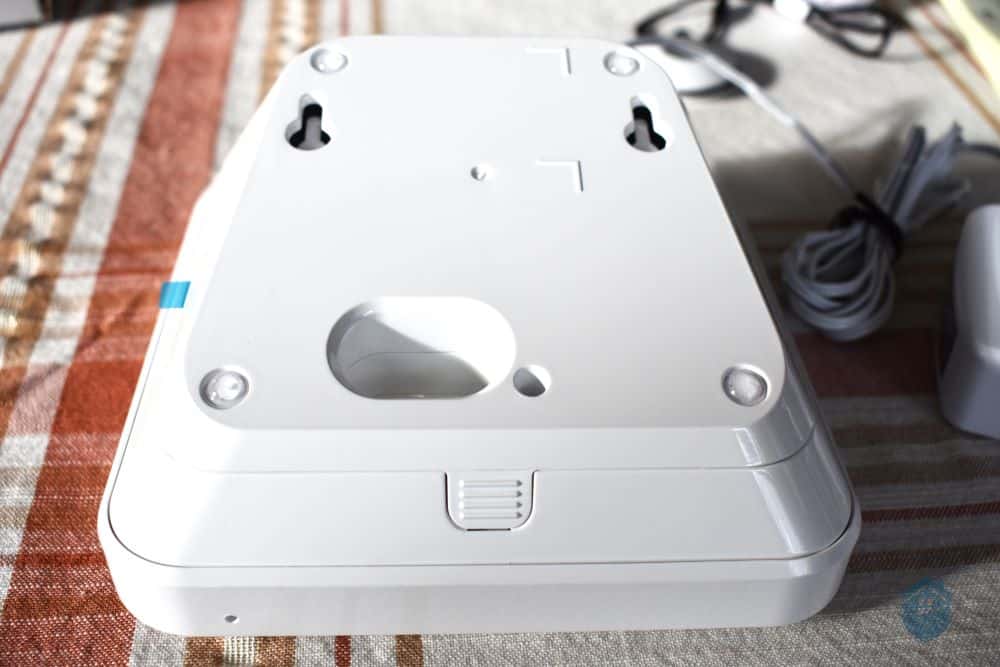
Back of GetSafe Control Panel
Moving on, we were instructed to insert a backup battery and then turn the power switch on to be sure the battery was working. Upon opening the cover, we noticed that the battery was already inserted. We did need to pop the battery in and out a few times before the blinking green power button indicated that the battery was in working condition, and the device was turned on. We consider this an important step as back-up batteries protect the user in the case of a power outage.
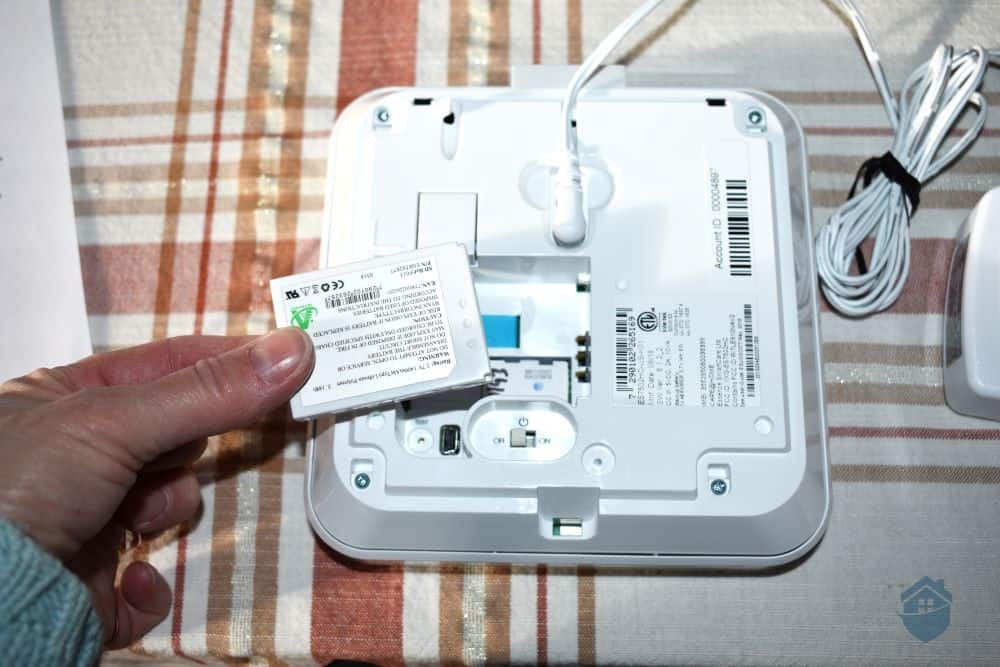
Setting up the GetSafe Control Panel
Next, we plugged in the base unit on our kitchen counter, and it did exactly what it was supposed to do. The emergency call button flashed blue momentarily and an automated voice told us that the control panel was on. That was easy.
The final step of the Quick User guide directed us to check out the LED indicators on the Control Panel. Note that three different symbols lie below the circular emergency call button. Each lights up solid or blinking red, green or orange, signifying different things. The back page of the guide provides a chart complete with colored illustrations of the indicators.
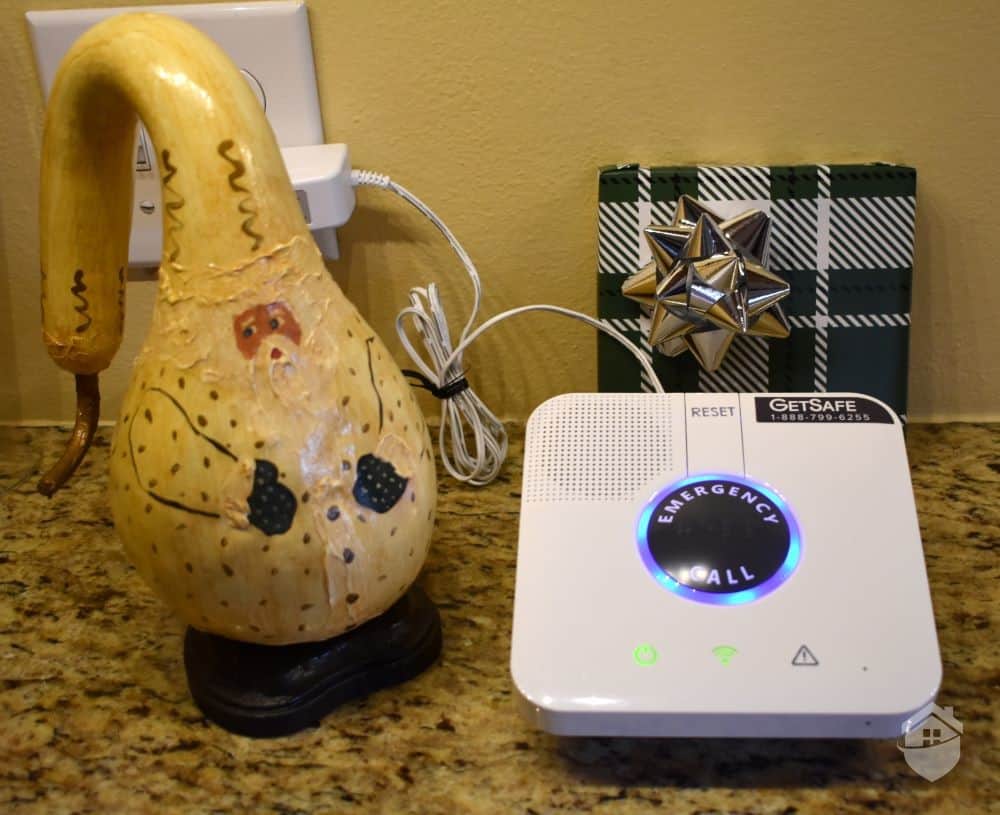
GetSafe Control Panel
For example, the communication symbol on the Control Panel is three curved lines above a single dot. When it lights up a solid green (shown above), it signifies that communication is available. A red light indicates that communication is unavailable perhaps because of a missing SIM-card. When the communication symbol is orange, it means an active emergency call is taking place.
Overall, the base unit has four types of LED indicators that communicate 14 different messages. Some lucky individuals have photographic memories. For the many of us who do not, we recommend keeping this nifty chart (see below) close to the control panel to help identify the symbols, at least in the beginning.
Did You Know? Speaking of memory, exercising your brain can strengthen connections between neurons or even build new connections. This helps maintain or improve memory and other cognitive functions.2 You can do this by learning to play an instrument or a new language, challenging yourself to a game or crossword puzzle….or figuring out all of the LED indicators on your new alert system!
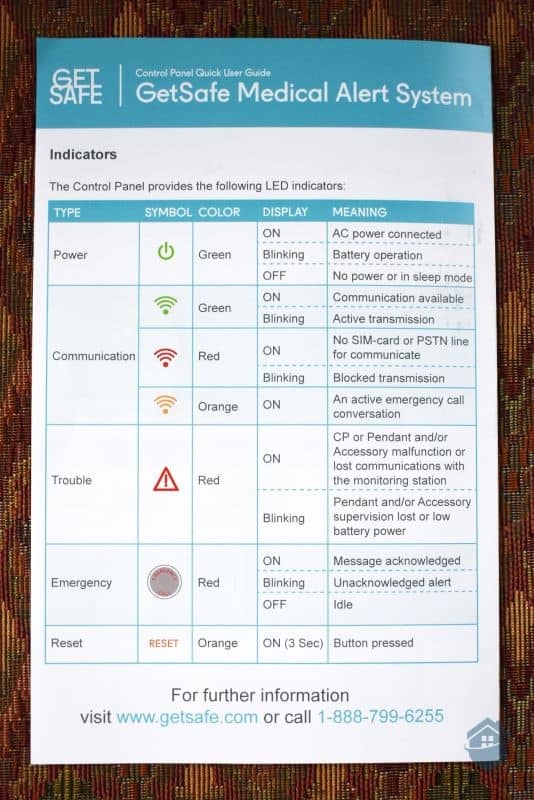
GetSafe User Guide
So now that we knew our base unit worked, our next question was how well did it work?
One of GetSafe’s most notable features is its high-fidelity, noise-cancelling microphone. By saying, “Call 9-1-1. Call 9-1-1,” we were able to alert the monitoring center without pushing a button or pulling a cord.
On the GetSafe website, a claim is made that the unit is “incredibly loud and impossibly sensitive.” We had already heard the automated voice, and we have to say, we definitely agree. In fact, it is annoyingly loud. And this is good! Because GetSafe is a system that operates without wearables that have two-way talk, it is important that users can communicate with an emergency response agent from a distance.
We wondered how great that distance could be. We went back to the website and read that the unit will pick up sound “even if you’re several yards away.” We put this claim to the test. First, we pressed the emergency button and stood in a far corner of the next room. We were about six yards away from the unit and able to both hear and speak to the monitoring center representative. GetSafe’s claim does hold up.
Next, we tried it about seven yards away and with a partial wall separating us. This time we could clearly hear the agent, but he could not hear us. This means that we would need one, possibly two, extra devices to cover the area on the ground floor of our house that the base couldn’t reach. So this is something to consider.
Now that the base unit was set up and working properly, we turned our attention to the two mini-consoles (also referred to as voice-activated wall buttons or voice panic detectors). We were a bit perplexed why one device had several names. In any case, we will call them mini-consoles, and we placed one upstairs in our master bedroom and one in our living room.
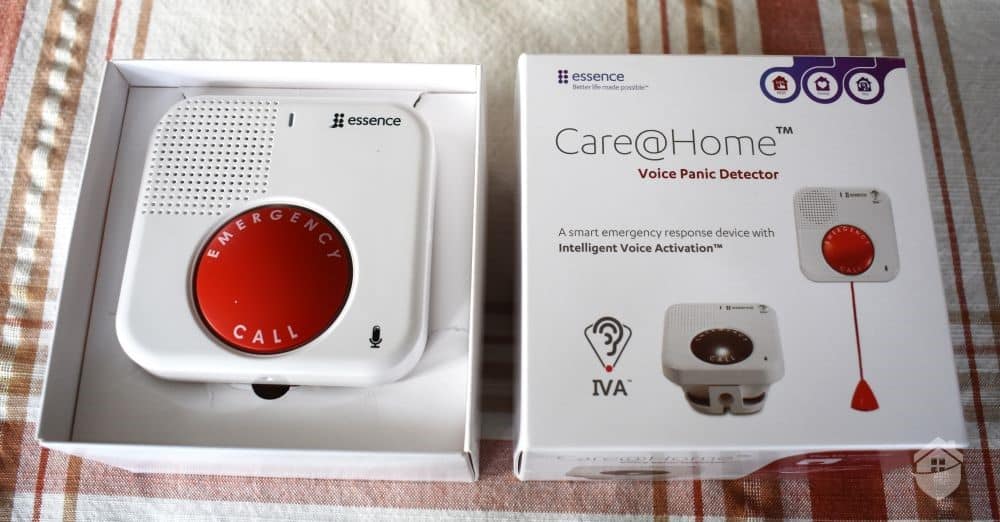
Unboxing the GetSafe Mini Console
If struggling to decide where to place your devices, it might be helpful to consider that bedrooms and living rooms can be high-risk areas, as well as kitchens and bathrooms.
Did You Know? In our research, we found that 30-50% of falls are due to environmental factors, such as slippery floors and uneven surfaces.3 And believe it or not, bathrooms aren’t the most high-risk fall areas of the home; other than stairways, the bedroom and living room are the highest-risk areas for slips and falls.4
We really liked the small size of the mini-console, only 3 ¾ inches square, making it unobtrusive and fairly discreet in our home. We were also pretty surprised by the design of the device, which allowed us to select placement options. For example, it comes with an easily attachable table mount that enables you to set it firmly on a bathroom counter top or bedroom dresser.
If you prefer to hang the device on a wall, two solid sticky strips are already secured on the back. GetSafe even includes an alcohol wipe in the package to use before sticking it to the wall. In addition, a detachable pull cord hangs from the mini-console. We thought the cord might be useful in a place such as the bathroom; if you or your loved one has a medical emergency while bathing and can’t get out of the tub, the cord is an easy thing to reach for. Here, have a look…
Could it also be a strangulation risk? We don’t think so. While strong, the sticky strips attaching the mini-consoles to the wall aren’t strong enough to support a person’s weight. Of course, if there are children living with you, it’d be best to put the mini-console in a place that is a little harder to reach for them, such as the far-end wall of the bathroom.
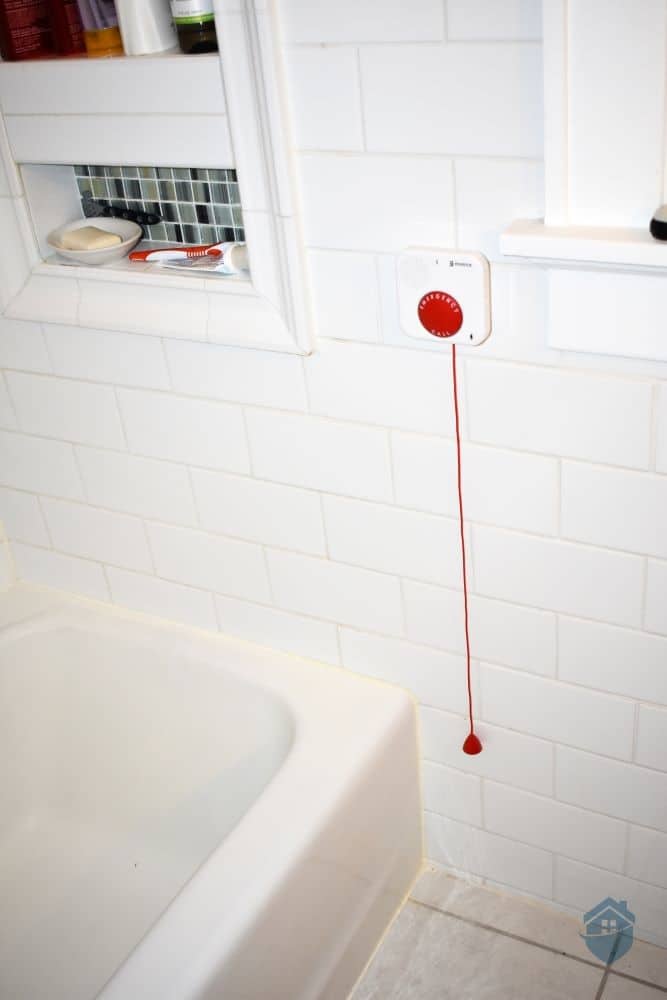
GetSafe Mini Console Installed in Bathroom
Because we know that response time is essential to health outcomes in the case of an emergency, we tested the devices several times in different locations and at different times of the day. Although there was one outlier of 40 seconds, in all other cases response times were under 30 seconds, the industry average. Response time refers to the time between pressing the emergency button and receiving a response from a monitoring center associate. GetSafe’s average response time was 28 seconds. Not bad!
We recommend watching the short video below to get a sense of GetSafe’s response time and what to expect when you or your loved one presses the button or calls for help.
We also had very positive experiences with both the representatives from the monitoring center (those responding to emergencies or equipment tests) and customer service (those answering questions via phone). The individuals with whom we spoke, including Angela, were calm, courteous and helpful.
GetSafe’s monitoring center is UL-certified in all 50 states. This means that it meets the standards for certification from United Laboratories, a third-party certification company that has been around for over a century and sets industry standards for products including industry equipment and home appliances.
We felt comfortable that we would get the help that we needed in the case of an emergency.
GetSafe offers several optional accessories with its alert system. One is a wearable device, a pendant which can be worn either on a lanyard around your neck or attached to a wristband. The pendant is a complimentary add-on for both the standard and select packages. While you might have some protection in your yard, you won’t be able to wander down the street while remaining protected, as it’s meant for at-home use only. We tested the range in our own backyard, and were able to successfully connect with the base unit from approximately 20 yards away.
Pro Tip: If you prefer a wristband over a lanyard, be sure to specify this when ordering your GetSafe alert system. By default, the pendant is sent with the lanyard. The wristband does not include an additional cost.
Because GetSafe is marketed as a wearable-free medical alert system, it seemed odd to us to include a pendant. After thinking about it, we wondered if it might be useful for that person who might try it out but not want to wear it all of the time, forget to wear it at times, or even resist wearing it in the beginning. We concluded that the more coverage a senior has, the better. It might also bring greater peace of mind for loved ones.
With that said, it is important to keep a few things in mind regarding the pendant. First, its features are limited. It does not include a microphone and speaker, so two-way talk is not available. Other companies create more sophisticated pendants that do this, like One Call Alert, and even smart watches that include GPS monitoring, like Lively offers. If you’re curious, we recommend reading our hands-on review of One Call Alert, or our Lively alert system review.
Second, the complimentary pendant does not include fall protection. To be honest, we were not certain whether the pendant that came with our package included fall detection until we called the company and asked about it. Angela, our customer service representative, confirmed that our pendant did not have fall detection. She also explained that it could be added at an extra cost of $10 per month but could only be used for pendants worn around the neck. This is pretty standard; even our highest-rated alert systems, like Medical Guardian, charge extra for fall detection.
Buyer Beware: Few, if any, fall detection devices worn around the wrist work as effectively as those worn around the neck. So be sure to do your research if you do purchase a wrist-worn fall detection device.
While we strongly recommend the use of fall detection devices, we also recognize that most people who choose GetSafe don’t intend to use a wearable regularly. Because GetSafe requires an extra $10 fee per month, this might be one situation where the fall detection is not worth the cost.
However, another add on could be used to fill in the gaps.
Rather than paying for fall detection, one alternative might be to purchase an extra wall button for high risk areas that are not already covered. This might be the bottom of a second staircase or within an additional bathroom or bedroom.
In our case, we would place an extra wall button at the base of our basement stairs which leads to our laundry room. Poor balance/mobility plus a narrow staircase plus hands full with laundry equals high risk area. Each standard wall button costs $35 while the voice-activated mini-consoles cost $79 each. If you’re trying to decide between the two, we’d say go for the voice-activated ones since these can be used to call for help even if it’s not within arm’s reach of you or your loved one.
Many companies that manufacture medical alert systems include freebies in their packages. In the case of GetSafe, this extra was a simple item called the Vial of Life. Not exactly a “vial,” it is a small booklet that can be used to fill in emergency medical information including your primary language, insurance information, current medication, allergies, and medical history. The Vial of Life keeps all of this vital information in one place, protected in a plastic envelope with a magnet on the back to stick on the fridge, where EMS can easily find it during an emergency.
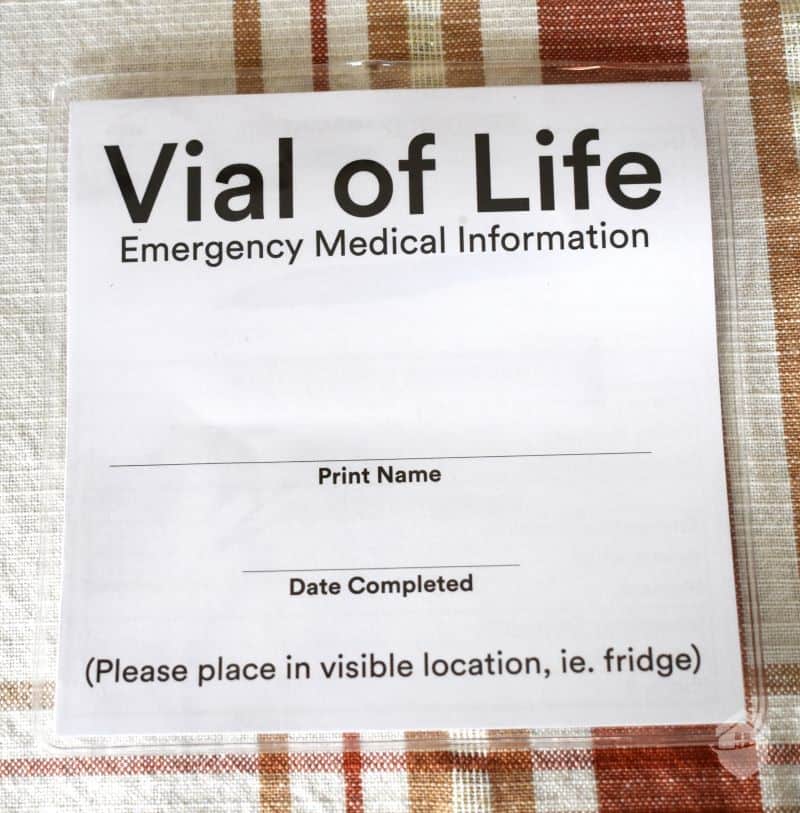
GetSafe Emergency Information
GetSafe is targeting a subset of older adults — those who don’t or won’t use a wearable medical alert device. For these individuals, we think that the medical alert system has accomplished what it set out to do.
For all other older adults, we think that a wearable device might provide more consistent and reassuring coverage. Every person’s house is designed differently. What happens if a medical emergency occurs in that spot that you don’t spend much time in and don’t have access to an emergency button? Wearables simply provide a better safety net.
But staying focused on GetSafe for the subset mentioned above, we found much we liked. This included the polite and competent associates from the monitoring center and customer service. We also appreciated the number and variety of devices that are available to set up around the house. And they all worked as advertised on GetSafe’s website.
Finally, the fall detection option poses a slight dilemma. We think that fall detection is a critical innovation with medical alert systems, a valuable component that every senior should utilize. GetSafe does offer this option, but only with the wearable device. And if you’re buying a wearable, we’d sooner recommend looking into a company like Bay Alarm Medical (see our Bay Alarm review here). We applaud GetSafe for offering a fall detection option, but we recommend that seniors forgo the extra cost and instead purchase extra buttons to place around the house.
Overall, we think GetSafe provides plenty of value for folks who absolutely don’t want to wear a button day and night, but it’s also not the only option. For example, Aloe Care Health offers a more tech-advanced solution centered on its voice-activated Smart Hub, while also offering traditional features like on-the-go mobile systems for seniors who have a more active lifestyle. You can explore their Essentials Plus system (at-home and on-the-go) in our Aloe Care Health review and you’ll find that like GetSafe, wearables are optional for this brand.
Yes, the pendant is waterproof. It also has a five-year battery life.
If the emergency button is pushed but a monitoring center associate cannot hear you, they can call your emergency contacts, and they will ultimately call 911 on your behalf. A Personal Protection Plan will be included in the package that you receive. On this form, you will be asked to include contact information for three friends or family members who agree to be contacted in the case of an emergency.
No. When relying on the voice activation, you are instructed to use a specific set of words: ”Call 9-1-1. Call 9-1-1.” Other household noise should not set off the alert. Our large barking dog didn’t set the alert system off, so I think GetSafe is on to something.
The battery life on the base is 32 hours, so you’ll remain covered for a while after your power goes out.
Although GetSafe began selling home security systems in 2015, it is no longer doing so. They are focusing all of their resources towards medical alert systems.
National Institute on Aging. (2017, March 15). Prevent Falls and Fractures.
https://www.nia.nih.gov/health/prevent-falls-and-fractures
Aging Well Vol. 3. (2010). Brain Fitness Games: The Real Deal? Today’s Geriatric Medicine.
https://www.todaysgeriatricmedicine.com/archive/020110p22.shtml
NCBI. Dionyssiotis, Y. (2012, September 28). Analyzing the problem of falls among older people.
https://www.ncbi.nlm.nih.gov/pmc/articles/PMC3468115/
Fall Prevention Center of Excellence. (Retrieved Dec. 21, 2020). Where Do Falls Among Older Adults Occur Most Frequently? USC Leonard Davis School of Gerontology.
http://stopfalls.org/faqs/where-do-falls-among-older-adults-occur-most-frequently/
Public Policy Institute. (2002, March). AARP.
https://assets.aarp.org/rgcenter/il/ib56_falls.pdf